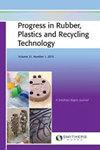橡胶-橡胶共混物:评述
IF 1.6
4区 材料科学
Q4 MATERIALS SCIENCE, COMPOSITES
Progress in Rubber Plastics and Recycling Technology
Pub Date : 2020-08-01
DOI:10.1177/1477760619895002
引用次数: 23
摘要
不同橡胶的共混是最终产品达到所需性能的有效方法之一。本文综述了橡胶-橡胶共混物及其填充体系的热力学考虑。本文讨论了影响橡胶共混物形貌的因素(即填料、硫化剂和其他复合成分的分布机理)和橡胶-橡胶共混物的制备技术,并着重讨论了它们的优缺点。显微镜是所有材料科学家感兴趣的领域。在橡胶共混物的情况下,显微镜是了解橡胶-橡胶共混物中相和填充颗粒的形态,即大小,形状和分布的必要工具。本文综述了基于光学显微镜、电子显微镜和原子力显微镜研究橡胶-橡胶共混物的科学报道。橡胶材料是一种复杂的大分子;填料、加工助剂和固化剂的比例显著;因此,关于填充橡胶-橡胶共混物微观方面的研究报道很少。特别是,橡胶共混物组成、填料(微纳米长度尺度)和加工助剂对橡胶共混体系形貌的影响尚未在科学文献中得到系统的回顾和讨论。因此,在目前的情况下,这篇综述被认为是处理橡胶-橡胶共混的基本背景,混相和各种橡胶共混体系的显微镜形态表征。需要补充的是,尽管在科学文献中有关于这些方面的零散信息,但迄今为止尚未发表一篇全面的综述。本文还讨论了使用显微镜表征橡胶-橡胶共混物的优点、缺点、人工制品和新挑战。本文章由计算机程序翻译,如有差异,请以英文原文为准。
Rubber–rubber blends: A critical review
The blending of different rubbers is one of the effective methods to achieve required performance properties in their final products. This article reviews the thermodynamic considerations of rubber–rubber blends and their filled systems. Factors affecting the rubber blend morphology (i.e. distribution mechanism of fillers, curatives and other compounding ingredients) and preparation techniques for rubber–rubber blends emphasizing their advantages and disadvantages are well discussed in this review. Microscopy is the field of interest to all material scientists. In the case of rubber blends, microscopy is an essential tool in order to understand the morphology, that is, size, shape and distribution of phases and filler particles in the rubber–rubber blend. In this review, selected scientific reports based on optical microscopy, electron microscopy and atomic force microscopy in rubber–rubber blends are discussed. Rubber material is a complex macromolecule; it has significant proportion of fillers, processing aids and curing agents; therefore, only a very few studies have been reported on the microscopic aspects of filled rubber–rubber blends. In particular, influence of rubber blend composition, fillers (micro and nano length scales) and processing additives on the morphology of rubber blends systems has not been systematically reviewed and discussed in the scientific literature. Therefore, in the present scenario, this review was thought of, which deals with the essential background to rubber–rubber blends, miscibility and morphological characterization of various rubber blend systems by microscopy. It is very important to add that although there is scattered information on these aspects in the scientific literature, to date a comprehensive review has not been published. The pros, cons, artefacts and the new challenges on the use of microscopy for the characterization of rubber–rubber blends are also discussed here.
求助全文
通过发布文献求助,成功后即可免费获取论文全文。
去求助
来源期刊

Progress in Rubber Plastics and Recycling Technology
MATERIALS SCIENCE, COMPOSITES-POLYMER SCIENCE
CiteScore
4.40
自引率
7.70%
发文量
18
审稿时长
>12 weeks
期刊介绍:
The journal aims to bridge the gap between research and development and the practical and commercial applications of polymers in a wide range of uses. Current developments and likely future trends are reviewed across key areas of the polymer industry, together with existing and potential opportunities for the innovative use of plastic and rubber products.
 求助内容:
求助内容: 应助结果提醒方式:
应助结果提醒方式:


